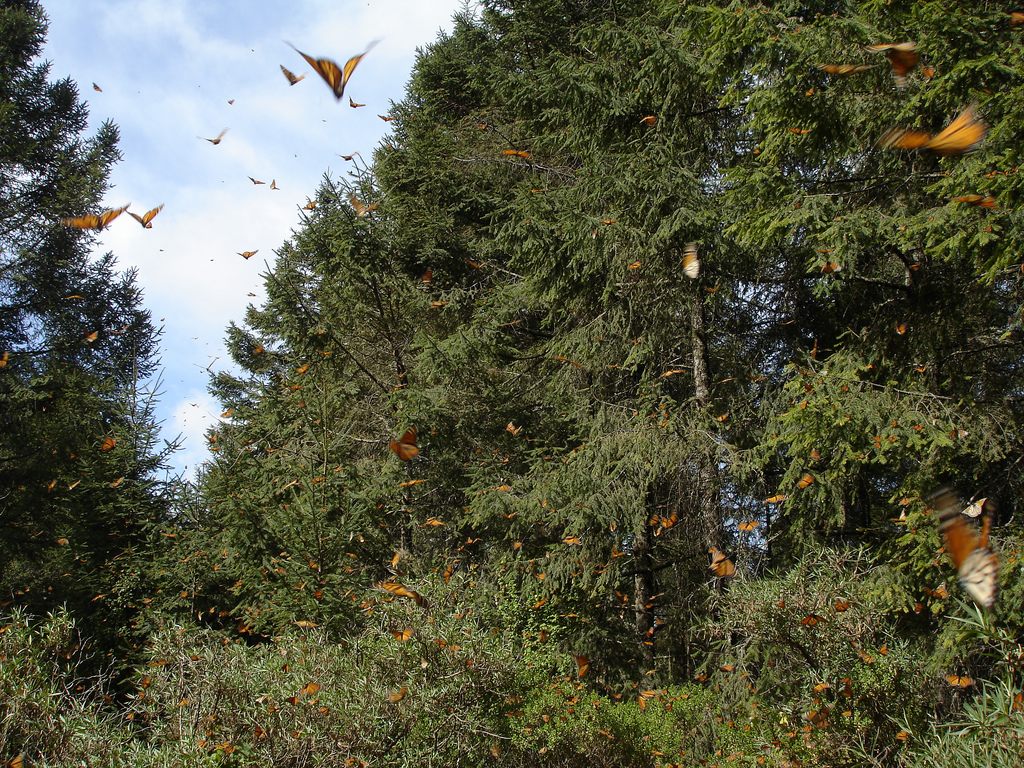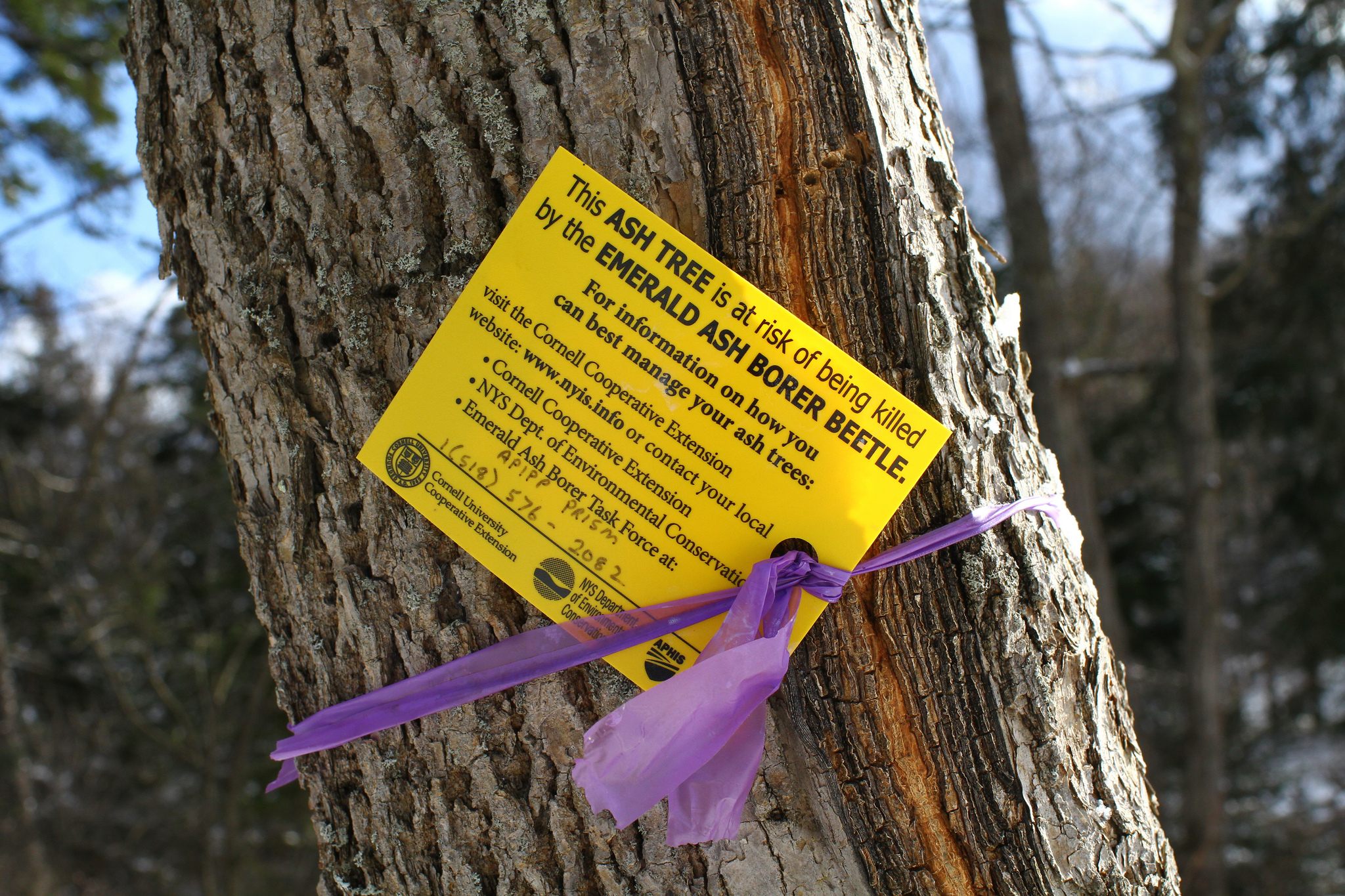Tag, You’re an Insect
Tracking small creatures is frustrating, delicate, fascinating work.

If you spot a butterfly alighting on a twig, a beetle skittering around a tree trunk, or an ant marching along the ground, maybe you wonder what it’s doing when you’re not looking. Where did it come from, and where is it heading?
Scientists do all sorts of things to hack our way into understanding daily life for individuals and groups across the animal kingdoms—often by trying to tag along from a distance. They secure GPS collars to elephants, fasten accelerometers to moon jellies, and outfit birds with satellite transmitters or color-coded bands. These data can be a window into a species’ range, diet, and behavior—illuminating, for instance, whether feral cats in Australia decimate local wildlife or the degree to which melting ice is starving polar bears.
Among these animals, insects are not the most willing scientific collaborators. Small and short-lived, they’re not really built to carry tracking tools we might want to use (assuming, that is, we can find them at all). For entomologists, engineers, and other scientists, getting an insect-eye-view is worth the trouble. Tagging and tracking insects offers insights into everything from mass migrations to colony behavior to their destructive appetites for trees and crops. Here are three examples of how researchers have tried to hitch rides with insects, and what they learned along the way.
Monarch Butterflies
Monarch butterflies don’t abide being cold. As summer turns to autumn, the butterflies hit the road. In the United States and Canada, those west of the Rocky Mountains fly to California, to roost in coastal groves. East of the mountains, they head to Mexico. Some of these insects flutter more than 3,000 miles, and they return to the roosts of their ancestors. Upwards of a billion monarchs descend on Mexico’s montane forests each year. In the reserves of El Rosario and Sierra Chincua, in Michoacán, they blanket the branches of Abies religiosa, or sacred firs, like orange-and-black shag.
To map the butterflies’ routes—and determine how many make it to the finish line—naturalists often tag them soon after they emerge from their chrysalides. Rondeau Provincial Park, in southwestern Ontario, Canada, hosts an annual tagging festival. Countless monarchs lay eggs there each summer, on milkweed plants close to the shore of Lake Erie. Every fall, naturalists and volunteers do their best to intercept close to 1,000 of them, press a sticker on each one, and send it on its way.

Tagging occurs in sand dunes, marsh, and scattered gardens, where butterflies land on rosy Joe-Pye weed or bushy blazing star. “Since [monarchs] don’t travel together in flocks like birds do, the migration is more of a constant flow through our park over the span of two or three months,” says Caitlin Sparks, a senior interpreter there. They may not reach the densities they do in Mexico, but, Sparks says, “they roost together in groups at night in the branches of trees, which is a magical sight.”
The park participates in a program spearheaded by Monarch Watch, a project out of the University of Kansas. The program’s tags are tiny—about the diameter of the eraser on a pencil—and lightweight. When the monarchs are nectaring on flowers, volunteers cover them with conical mesh nets. The insects instinctively fly up toward the tip. Monarch Watch recommends that the human tagger then gingerly use her thumb and forefinger to press a tag onto the mitten-shaped discal cell of the butterflies’ wing. This is close to the insect’s center of gravity, so it doesn’t throw them off. Each tag is marked with an email address, a phone number, and a unique code of three letters and three numbers. Taggers use a spreadsheet to log the butterflies they encounter. The hope is that someone else will use this code to identify the butterfly on the other side of the journey.
It took years to arrive at the tag’s simplicity and placement. At first, Monarch Watch emulated a strategy from the 1970s, in which researchers rubbed scales off the wings to make a space for rectangular labels to adhere. When Chip Taylor, the program’s director and a professor emeritus of ecology at the University of Kansas, tried this approach in 1992, he found that monarchs were getting mangled. “Too many wings were broken in the process of rubbing the scales, and then your butterflies are dead, right?” Then, he tried a little tag on the underside of the hindwing. Those came with little bottles of adhesive, but volunteers couldn’t figure out exactly how much to use. (There were reports of butterflies getting glued to the grass, sidewalk, or fingers.) The team settled on the current approach in 1997.

Monarch Watch collaborates with local experts in Mexico, but the data they acquire together doesn’t paint a complete picture. The goal is that local farmers will collect the tags from butterflies moving through the mountains, and save them until Monarch Watch teams arrive to collect them. (Monarch Watch pays a $5 finders’ fee for each recovered tag.) The ratio of tags recovered to those affixed is still low. Of 1.4 million that have been affixed to monarchs over the last two decades, the team only has data from roughly 14,000.
But the work continues. “We want to learn something about migration, the entire flow, and how it varies from year to year,” Taylor says. Monitoring these dynamics could help researchers understand where the butterflies are hatching and inform conservation efforts in those habitats, which are vanishing across the American Midwest. It could also elucidate the relationship between climate and migration. This year, which has seen a rash of warm weather across the Midwest, Taylor says, “migration is way behind schedule.”
Emerald Ash Borers
These iridescent beetles, native to Asia and otherwise known as Agrilus planipennis, were first detected in America in 2002, when they turned up in Michigan. Researchers suspect that they’d been hanging around for a while before anyone noticed—but when we did, things began to deteriorate quickly. The beetles have a taste for 16 species of ash trees, and have been blamed for destroying millions of them across 30 states. Signs of an infestation include denuded limbs, unusual branching from the trunk, and deep splits in the bark. Researchers know that, in early summer, the beetles push their way out of holes that look a bit like cat eyes.

What they do next is what Deborah McCullough wanted to figure out. A forest entomologist at Michigan State University’s College of Natural Resources, McCullough once reared loads of these beetles and marked them with tiny dabs of non-toxic paint. (One related approach, which gained some traction in the 1960s, involved marking millions of notorious crop pests with traces of fluorescent dust.)
McCullough’s work hit one big snag. “Once we released them, we never saw them again,” she says. “Those beetles are really good fliers and there are no good attractants or methods to trap them.” The result? “Lots of time and effort—no data.” McCullough knows of another project that tried a similar approach with tiny transmitter wires. That one stalled out, too, she says, without ever making it to the wild. “Beetles are just way too small to carry something around,” McCullough says, “even if it’s just a tiny piece of wire.”

There’s much more to learn about where the beetles go, and when, and why. So far, at least, tracking doesn’t seem to be the answer. In an effort to hem the beetles in, at least, the U.S. Department of Agriculture emphasizes limiting the movement of firewood, since they often infest the bundles. The agency recommends buying local firewood and burning the whole pile.
Termites
Kirstin Petersen, now an engineer at Cornell University, works in the field of collective embodied intelligence. The idea is that actors—in her case, small robots—can plow through tasks really efficiently as a group when they collaborate and respond to sensory information. In the insect world, there’s a species that has this whole thing down already. So, a few years ago, she figured she better take a closer look at termites.
Petersen had already gone deep into the existing literature on termite behavior, but she hadn’t seen a colony in action, up close. So, back when she was a graduate student, she and her collaborators trailed an entomologist to Namibia, where they gawked at the towering, Seussian mounds that termite colonies build, and then had to decide how best to figure out what was going on inside.

The team set out some traps, and then relocated the insects to a petri dish. In the lab, the termites were easy enough to see, but marking them was a slog. And the termites, which are used to being busy, seemed to be lethargic, something that the long time needed to mark them made even worse. “Their behavior deteriorates the longer they’re away from the mound,” Petersen says.
So the team came up with a way to track the termites using marks they already have. With semi-automated software, they focused on the brightest spot on an insect’s abdomen, and then used that to follow the individual’s behavior. They rigged up an overhead camera and measured each termite’s movement from one frame to another (with later verification by humans). This approach slashed the hands-on time. Marking them manually would have taken weeks, Petersen says. The software worked it out in hours. Also, “we wouldn’t be dealing with tired termites,” she adds.

Petersen saw that there is a lot of variety in how specific termites went about their days. “Some were explorers, and some were home-based, taking care of maintenance,” she says. That kind of variation can be engineered into robot colonies, too. Say the robots are constructing a building. Maybe they’d benefit from having a bit of latitude to do their thing, and executing different tasks in different ways. “Instead of asking them to build according to a blueprint, we can do it like the termites,” Petersen says, by giving them broad parameters, such as specifying that a kitchen should be close to a bathroom, for instance, or that stairs belong near an elevator.
With collaborators at Cornell, Petersen is now looking skyward, and developing a method of tagging honeybees with thermal sensors in order to map their foraging tactics. “Engineers have a lot to learn from behavioral biologists,” she says. “And what they learn from nature.”

















Follow us on Twitter to get the latest on the world's hidden wonders.
Like us on Facebook to get the latest on the world's hidden wonders.
Follow us on Twitter Like us on Facebook